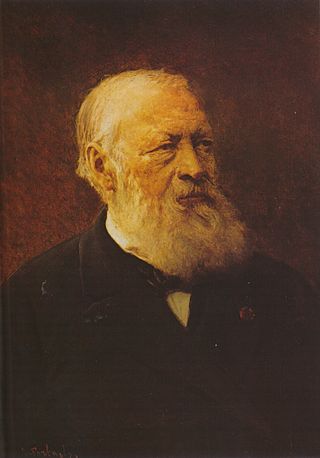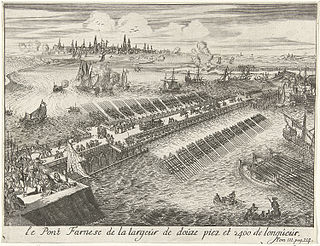
A citadel is the most fortified area of a town or city. It may be a castle, fortress, or fortified center. The term is a diminutive of city, meaning "little city", because it is a smaller part of the city of which it is the defensive core.

The Scheldt is a 435-kilometre-long (270 mi) river that flows through northern France, western Belgium, and the southwestern part of the Netherlands, with its mouth at the North Sea. Its name is derived from an adjective corresponding to Old English sċeald ("shallow"), Modern English shoal, Low German schol, West Frisian skol, and obsolete Swedish skäll ("thin").

Henri (Hendrik) Conscience was a Belgian author. He is considered the pioneer of Dutch-language literature in Flanders, writing at a time when Belgium was dominated by the French language among the upper classes, in literature and government. Conscience fought as a Belgian revolutionary in 1830 and was a notable writer in the Romanticist style popular in the early 19th century. He is best known for his romantic nationalist novel, The Lion of Flanders (1838), inspired by the victory of a Flemish peasant militia over French knights at the 1302 Battle of the Golden Spurs during the Franco-Flemish War.

The siege of Antwerp was an engagement between the German and the Belgian, British and French armies around the fortified city of Antwerp during the First World War. German troops besieged a garrison of Belgian fortress troops, the Belgian field army and the British Royal Naval Division in the Antwerp area, after the German invasion of Belgium in August 1914. The city, which was ringed by forts known as the National Redoubt, was besieged to the south and east by German forces.

The Belgian Revolution was the conflict which led to the secession of the southern provinces from the United Kingdom of the Netherlands and the establishment of an independent Kingdom of Belgium.

The fall of Antwerp on 17 August 1585 took place during the Eighty Years' War, after a siege lasting over a year from July 1584 until August 1585. The city of Antwerp was the focal point of the Protestant-dominated Dutch Revolt, but was forced to surrender to the Spanish forces under the command of Alessandro Farnese. Under the terms agreed, all the Protestants of Antwerp were given four years to settle their affairs and leave the city. Many migrated north, especially to Amsterdam. Apart from losing a high proportion of its middle class and mercantile population, Antwerp's trade suffered for two centuries afterwards as Dutch forts blockaded the River Scheldt until 1795.

David Hendrik, Baron Chassé was a Dutch soldier who fought both for and against Napoleon. He commanded the Third Netherlands Division that intervened at a crucial moment in the Battle of Waterloo. In 1830 he bombarded the city of Antwerp as commander of Antwerp Citadel during the Belgian Revolution.

The Port of Antwerp is the port of the city of Antwerp, Belgium. It is located in Flanders, mainly in the province of Antwerp, but also partially in East Flanders. It is a seaport in the heart of Europe accessible to capesize ships. It is Europe's second-largest seaport, after that of Rotterdam. Antwerp stands at the upper end of the tidal estuary of the Scheldt. The estuary is navigable by ships of more than 100,000 Gross Tons as far as 80 km inland. Like the Port of Hamburg, the Port of Antwerp's inland location provides a more central location in Europe than the majority of North Sea ports. Antwerp's docks are connected to the hinterland by rail, road, and river and canal waterways. As a result, the port of Antwerp has become one of Europe's largest seaports, ranking second behind Rotterdam by total freight shipped. Its international rankings vary from 11th to 20th (AAPA). In 2012, the Port of Antwerp handled 14,220 sea trade ships, 57,044 inland barges, and offered liner services to 800 different maritime destinations.

The ten days' campaign was a failed military expedition by the United Kingdom of the Netherlands against the secessionist Kingdom of Belgium between 2 and 12 August 1831. The campaign was an attempt by the Dutch King William I to halt the course of the Belgian Revolution which had broken out in August 1830.

The siege of Antwerp took place after fighting in the Belgian Revolution ended. On 15 November 1832, the French Armée du Nord under Marshal Gérard began to lay siege to the Dutch troops there under David Chassé. The siege ended on 23 December 1832. The French had agreed with the Belgian rebels that the latter would not participate in the battle.

In August 1572, during the course of the Eighty Years' War, the city of Goes, in the Spanish Netherlands, was besieged by Dutch forces with the support of English troops sent by Queen Elizabeth I. This was a menace to the safety of the nearby city of Middelburg, also under siege. Given the impossibility of rescue of Goes by sea, 3,000 soldiers of the Spanish Tercios under the command of Cristóbal de Mondragón waded across the river Scheldt at its mouth, walking 15 miles overnight in water up to chest deep. The surprise arrival of the Tercios forced the withdrawal of the Anglo-Dutch troops from Goes, allowing the Spanish to maintain control of Middelburg, capital of Walcheren Island.

Antwerp is a city and a municipality in the Flemish Region of Belgium. It is the capital and largest city of Antwerp Province, and the third largest city in Belgium by area at 208.22 km2 (80.39 sq mi) after Tournai and Couvin. With a population of 565,039, it is the most populous municipality in Belgium, and with a metropolitan population of over 1.2 million people, the country's second-largest metropolitan area after Brussels.

Ferdinand de Braekeleer, sometimes spelled as Ferdinand de Braeckeleer, was a Flemish painter and printmaker. He is known for his paintings of genre scenes, church interiors, historic events, religious scenes, cityscapes, market scenes and market still lifes. He is called 'the Elder' to distinguish him from his son with the same name, who was also a painter.
The following is a timeline of the history of the municipality of Antwerp, Belgium.
Siege of Antwerp may refer to:

The Monster Mortar was one of the largest mortars ever developed. Also called Leopold or the Liège mortar, the 24 inches (610 mm) caliber mortar was conceived by the French artillery officer Henri-Joseph Paixhans. The mortar was manufactured under the direction of the Belgian Minister of War Baron Louis Evain and cast at the Royal Canon Foundry in Liège, Belgium in 1832. It saw action at the Battle of Antwerp in December 1832.

Antwerp was developed as a fortified city, but very little remains of the 10th century enceinte. Only some remains of the first city wall can be seen near the Vleeshuis museum at the corner of Bloedberg and Burchtgracht, and a replica of a burg (castle) named Steen has been partly rebuilt near the Scheldt-quais during the 19th century. Parts of the canals that protected the city between the 12th and 16th century have been covered and used as a sewage system. Both the 16th century city walls and the 19th century fortifications have been covered up by major infrastructure works during the 19th and 20th century.

The siege of Antwerp took place from 14 January 1814 to 4 May 1814, during the War of the Sixth Coalition. Led by Governor Lazare Carnot, Antwerp, then a French city, resisted an Allied siege until Napoleon's abdication and the signing of an armistice.

Antwerp Citadel was a pentagonal bastion fort built to defend and dominate the city of Antwerp in the early stages of the Dutch Revolt. It has been described as "doubtlesse the most matchlesse piece of modern Fortification in the World" and as "one of the most studied urban installations of the sixteenth century".
Events in the year 1830 in Belgium.



















